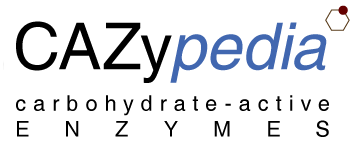19 July 2024: Chalk-up one more for the GTs! The
Glycosyltransferase Family 47 page joined the small group of
Curator Approved Glycosyltransferase Families pages in
CAZypedia today. This entry was
authored by Ph.D. students
Daniel Tehrani and
Charlie Corulli, and
Curated by
Breeanna Urbanowicz with input from
Kelley Moremen. Widely represented in plants,
GT47 members are anomer-
inverting glycosyltransferases, which are involved in the biosynthesis of several cell wall matrix polysaccharides. Representatives from mammals are involved in heparin biosynthesis. Correspondingly, members of
GH47 have diverse substrate specificities, including the transfer of both anionic and neutral monosaccharides to polysaccharides.
This is a great example where two keen Ph.D. students worked with their supervisors to create a valuable page for the scientific community. We encourage others to follow their lead, on your favorite family!
9 July 2024: Yet another new family of beta-1,2-glucan-active enzymes! Today, Masahiro Nakajima Curator Approved the Glycoside Hydrolase Family 186 page by Sei Motouchi. GH186 is a family of anomer-inverting enzymes from bacteria, members of which are specific for beta-1,2-glucans. Intriguingly, although some GH186 members work as classic glycoside hydrolases, others perform transglycosylation by wrapping the sugar chain around in the active-site, to position the 6-OH group of a terminal glucosyl unit for direct attack. Also notable, GH186 members appear to use an extended chain of water molecules to relay acceptor deprotonation by the general base residue, i.e. a Grotthuss mechanism. Check out the GH186 page to learn more about these interesting enzymes, and make sure to see the GH189, GH144, and GH162 pages from this same group.
2 May 2024: CBDs I to X... A major milestone! CBM families 1 to 10 are now complete! These are the old CBD (cellulose-binding domain) families, which used to have roman numerals as part of their nomenclature. A special thank you to all the authors and responsible curators who have contributed to this major milestone. Go have a peek at each of these old school families on their respective CAZypedia pages: CBM1, CBM2, CBM3, CBM4, CBM5, CBM6, CBM7, CBM8, CBM9, and CBM10.
> older news
